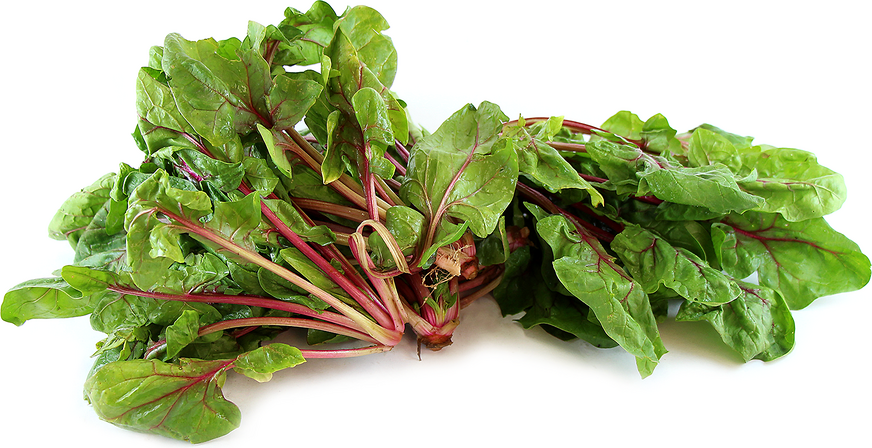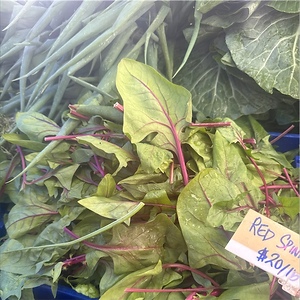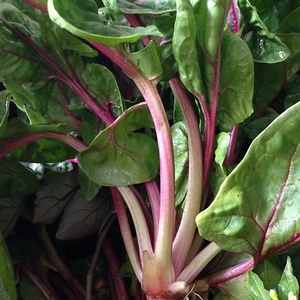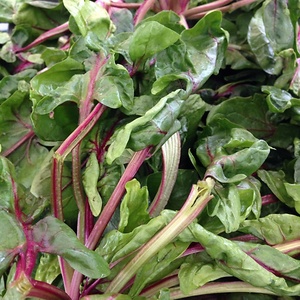


Red Spinach
Estimated Inventory, 3 lbs : 0
Description/Taste
Red spinach forms in low-growing rosettes with upright, semi-erect leaves attached to straight, cylindrical stems. The leaves are oval, oblong, to spade-shaped with a slightly pointed, curved tip, and each leaf is thick and textured, covered in lines, creases, and a raised texture. This gives the spinach a full, almost ruffled appearance, and there are also prominent veins spanning across the leaf’s surface. Red spinach typically has green to dark green leaves, contrasted with pale red to maroon stems. The leaves are crisp, springy, and chewy, developing a toothsome mouthfeel as they mature. Young Red spinach leaves will impart a delicate, crisp, and subtly sweet, earthy flavor when added raw to dishes. Mature Red spinach has a heartier nature and an earthy, green, and mineral-like flavor.
Seasons/Availability
Red spinach is available in the late winter through spring.
Current Facts
Red spinach, botanically classified as Spinacia oleracea, is a broad category encompassing many different varieties belonging to the Amaranthaceae family. Red spinach is a term that describes spinach varieties with red veins, stems, or leaves. It is important to note that Red spinach is also used to describe red-leafed amaranth, Amaranthus cruentus, but the two belong to different geneses and are considered distinct species. Red spinach is commercially cultivated worldwide, but it is also planted in home gardens, grown for its fast-maturing leaves, slow-bolting nature, resistance to some diseases, and cold-weather tolerance. The textured greens and colorful stems are also typically sold fresh in bunches and are utilized for their unique appearance as much as their mineral, earthy taste. Red spinach is a popular variety grown for its baby leaves or microgreens, and the leaves are versatile, being utilized in savory preparations in micro, baby, or mature form. There are several varieties of Red spinach, including rubino, red kitten, and bordeaux.
Nutritional Value
Red spinach is a source of vitamin K to assist in faster wound healing, vitamin A to maintain healthy organ functioning, and vitamin C to strengthen the immune system while reducing inflammation. The greens also provide calcium and phosphorus to build strong bones and teeth, magnesium to regulate nerve and muscle function, iron to develop the protein hemoglobin for oxygen transport through the bloodstream, and other nutrients, including folate, manganese, fiber, potassium, copper, and zinc. Spinach is valued for containing anti-inflammatory properties and antioxidants to protect the cells against the damage caused by free radicals.
Applications
Red spinach has an earthy, mineral-forward flavor and chewy texture well suited for fresh and cooked preparations. The greens are typically consumed in their young stages, mixed into salads as a baby green, a bed of lettuce, or utilized as a microgreen for an added crisp garnish. Red spinach can also be added in its mature state to salads, layered into sandwiches, or shredded into grain bowls, tacos, or rice dishes. To maintain the red pigments in the stems, veins, and leaves, depending on the variety, Red spinach can be briefly cooked and then shocked in an ice bath. This shocking process helps to maintain the leave’s colorful nature. Red spinach does lose some of its pigment when cooked for extended periods, and the mature leaves are popularly braised, steamed, braised, or baked. The greens can be sauteed in brown butter, gently wilted, and used as a bed of greens for seafood, stirred into soups and curries, or added at the end of stir-fries. Red spinach can also be incorporated into frittatas, quiches, omelets, or eggs benedict, cooked into souffles, blanched and mixed into cream-based sauces, made into a pesto, or wilted and tossed into pasta. Red spinach can be used in any recipe calling for spinach in general. Red spinach pairs well with aromatics such as ginger, garlic, chiles, and shallots, cheeses including feta, parmesan, mozzarella, goat, and cheddar, meats such as lamb, turkey, beef, pork, and poultry, seafood, and herbs including thyme, dill, basil, and parsley. Whole, unwashed Red spinach will keep for 1 to 2 weeks when stored loosely in a plastic bag in the refrigerator’s crisper drawer. The greens can also be frozen for extended use.
Ethnic/Cultural Info
The first true Red spinach was released in 2019 under the name USDA Red. Before this variety, Red spinach was a general descriptor for Spinacia oleracea varieties with red veins, stems, and green leaves. This misnaming often created confusion between true Red Spinach varieties and other pigmented greens such as red amaranth. USDA Red was made from self-pollination of red-veined spinach known as bordeaux through the United States Department of Agriculture’s Research Service, or ARS. The test plants were trialed in a field and were selected for their saturated coloring, continuing to be bred for several generations. From these plants, twenty-three were selected and allowed to cross-pollinate with each other in a controlled environment, creating a variety that exhibited red pigment in the leaves, veins, and stems. USDA Red spinach is considered one of the first true completely red cultivars, and the maroon coloring is derived from a phytonutrient known as betacyanin. This antioxidant is stronger than anthocyanin and helps to protect the body against the stress caused by free radical damage. The USDA hopes this new colorful variety will excite consumers and encourage them to integrate spinach into their diet as an everyday staple. The pigmented leaves are also being examined for their use in baby lettuce salad mixes, providing unique color and flavor to commercial prepackaged mixes.
Geography/History
Spinach is believed by botanists to be native to areas of ancient Persia, now known as modern-day Iran. The edible, domesticated greens were thought to have developed through selective breeding of wild, leafy species, but much of the history of spinach is unknown. Over time, spinach was spread to neighboring countries around Persia, traveling through India, and was introduced into Nepal and China sometime before 647 CE. Spinach was also brought to Italy around 827 CE through the Arabs, and by the 10th century, the plant was found throughout the Mediterranean. In the 13th through 16th centuries, spinach was extensively cultivated throughout Europe, creating new domesticated varieties, including red-veined spinach varieties. Red spinach was also carried to the New World and was planted in home gardens in the United States throughout the 19th century. Today Red spinach is cultivated worldwide and is offered through farmers markets, specialty retailers, and select grocers.
Recipe Ideas
Recipes that include Red Spinach. One
| Sweet C's Designs |
|
Red Spinach and Mushroom Frittata |
| Messy Witchen |
|
Stir-Fry Red Spinach |
| The Food Gays |
|
Red Spinach, Cherry ans Walnut Salad |










